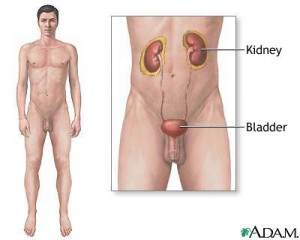What is Glycosuria?
Glycosuria is a condition that occurs when your urine contains more glucose or sugar than it should. Some of the main causes of glycosuria include kidney damage or high blood sugar levels. Glucose in urine is a symptom of both type 1 and type 2 diabetes.
When the blood contains too much glucose, the kidneys may be unable to retain it all and the body excretes blood sugar through the urine. For glycosuria to occur, blood sugar concentration has to exceed 10 mmol/L or 180 mg/dl.
Glycosuria can also occur when a person has low or normal blood glucose levels. This suggests a condition known as renal glycosuria.
What is Renal Glycosuria?
 Renal glycosuria is a rare condition that is typically caused by kidney damage. This condition occurs when a person’s kidneys are unable to reabsorb blood glucose despite the person having normal blood sugar levels.
Renal glycosuria is a rare condition that is typically caused by kidney damage. This condition occurs when a person’s kidneys are unable to reabsorb blood glucose despite the person having normal blood sugar levels.
As a result, glucose spills into the person’s urine in increasingly large amounts. Therefore, renal glycosuria is largely a problem with how the person’s kidneys are functioning. Glucose can also enter the urine with other substances such as uric acid and amino acids.
An example of renal glycosuria is Fanconi Syndrome, a genetic or acquired condition where the urine contains excess substances. On the other hand, people with diabetes who are taking SGLT-2 inhibitors, such as Jardiance and Invokana, might also have excess sugar in the urine.
Symptoms of Excess Glucose in Urine
A person with glycosuria can go for a long time without experiencing any significant symptoms. Urine tests can help reveal that they have the condition before the person even realizes they have it. This is usually a red flag for undiagnosed diabetes.
If untreated, glucose in the urine may cause symptoms such as:
- Dehydration or extreme thirst
- Extreme hunger
- More frequent urination
- Accidental urination
- Nighttime urination
People with diabetes may also experience other symptoms such as:
- Unexplained weight loss
- Fatigue
- Slow-healing abrasions and cuts
- Darkened skin near areas where the skin folds such as around the neck and near armpits
- Vision trouble
- Frequent infections
- Irritability
- Unusual sensations such as tingling in the feet and hands
An abnormally high amount of glucose in the urine is usually the result of high levels of blood sugar, which usually occurs in undiagnosed and untreated diabetes. Therefore, you should talk to your healthcare provider if you experience any unusual symptoms.
Seek immediate medical attention if you have glycosuria accompanied by other serious symptoms, including a foggy mind or the inability to think clearly, chest pains, unresponsiveness or passing out, and seizure.
Causes of Glucose in Urine
Glucose in urine is usually caused by conditions that result in elevated blood sugar levels such as diabetes or prediabetes, especially when untreated. Common causes of glycosuria include:
- Hyperglycemia (elevated blood sugar levels)
- Diabetes (affects the body’s ability to use glucose for energy)
- Prediabetes (abnormally high blood sugar levels that do not meet the criteria for diabetes diagnosis)
Other causes of Glucose in Urine
Glycosuria can also be caused by other conditions that are not linked to high blood sugar levels including:
- Pregnancy
- Nephrotic syndrome
- Kidney transplant
- Benign glycosuria: an inherited trait in which the kidneys’ filtering mechanism allows glucose to pass into the urine.
Potential Complications of Glucose in Urine
Glycosuria may also be associated with serious complications. Because diabetes is one of the main causes of glucose in the urine, untreated diabetes can result in life-threatening complications. Therefore, once the cause for sugar in the urine is diagnosed, you should adhere to the treatment plan designed by your doctor to reduce the risk of serious complications such as:
- Life-threatening cardiovascular complications, such as peripheral artery disease, cardiac arrest, high cholesterol levels, high blood pressure (hypertension), and stroke.
- Kidney failure or kidney infection
- Eye problems including diabetic retinopathy, macular degeneration, glaucoma, or blindness.
- Nerve damage
- Sores on feet and hands
How is Glycosuria Diagnosed?
Glucose in urine (glycosuria) can be diagnosed in several different ways, but a urine test (urinalysis) is one of the most common approaches.
For urinalysis, you’ll be asked to urinate on a test strip that will be sent to the laboratory for testing. If the amount of sugar in your urine is higher than 180mg/dl (milligrams per deciliter) in a single day, you may have glycosuria.
Your doctor may also conduct a blood test to check your blood sugar level. If you have elevated blood sugar levels and diabetes has not been previously diagnosed, your doctor may also perform A1C (glycated hemoglobin) test to get detailed information about your blood glucose levels over the past few months.
How is Glycosuria Treated?
 Glucose in urine is not a cause for concern if you don’t have any underlying conditions that are causing you to pass abnormally high amounts of sugar in your urine. However, if conditions like diabetes are causing your glycosuria, your healthcare provider will create a treatment plan specifically for you.
Glucose in urine is not a cause for concern if you don’t have any underlying conditions that are causing you to pass abnormally high amounts of sugar in your urine. However, if conditions like diabetes are causing your glycosuria, your healthcare provider will create a treatment plan specifically for you.
If diabetes is the cause of your glycosuria, your outlook will improve if you maintain a consistent management or treatment plan. Taking medications prescribed by your doctor, eating well, and exercising every day can keep you from developing any additional complications.

